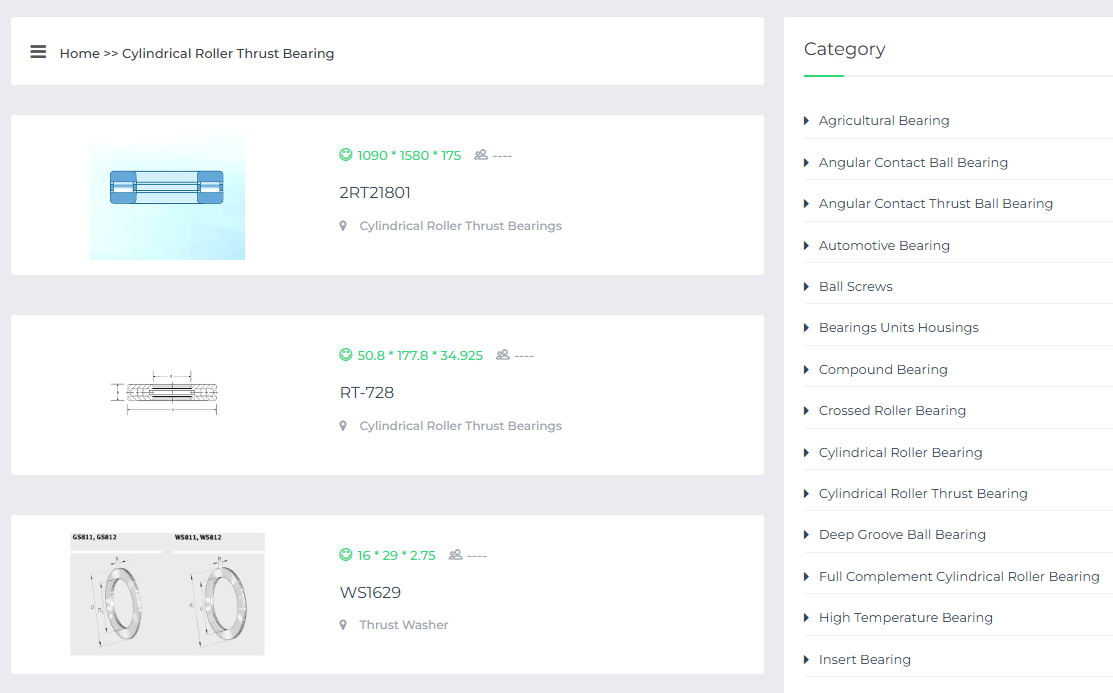Cylindrical roller thrust bearings are essential components in mechanical systems requiring the ability to handle high axial loads efficiently. These bearings consist of cylindrical rollers aligned perpendicularly to the bearing axis, offering robust performance in high-load and moderate-speed applications.
In this comprehensive guide, we’ll explore the features, benefits, applications, and factors to consider when selecting cylindrical roller thrust bearings, along with a reliable recommendation for sourcing top-quality bearings.
What Is a Cylindrical Roller Thrust Bearing?
A cylindrical roller thrust bearing is a type of bearing specifically designed to handle axial loads with minimal friction. Unlike ball bearings, which use spherical rolling elements, these bearings utilize cylindrical rollers, allowing for a larger contact area and, consequently, higher load-carrying capacity.
Key Features
- Axial Load Support: Optimized to handle significant axial forces.
- High Load Capacity: Thanks to the cylindrical rollers, these bearings can sustain heavier loads compared to other thrust bearings.
- Minimal Friction: Low rolling resistance ensures smooth operation.
- Rigid Construction: The design minimizes deformation under load.
Types of Cylindrical Roller Thrust Bearings
Single Direction Cylindrical Roller Thrust Bearings
- Designed to handle axial loads in one direction.
- Commonly used in industrial presses and machinery.
Double Direction Cylindrical Roller Thrust Bearings
- Capable of supporting axial loads in both directions.
- Often found in gearboxes and turbines requiring bidirectional thrust control.
Full Complement Cylindrical Roller Thrust Bearings
- Contains the maximum number of rollers for increased load capacity.
- Best suited for low-speed applications with heavy loads.
Benefits of Cylindrical Roller Thrust Bearings
1. High Load Capacity
The cylindrical rollers distribute the load over a larger surface area, making them ideal for heavy-duty applications.
2. Durability
The robust design ensures long service life, even under challenging operating conditions.
3. Efficiency
Low rolling resistance reduces energy consumption, contributing to more efficient machinery.
4. Versatility
These bearings are available in a variety of sizes and configurations to meet diverse industrial needs.
5. Precision Performance
Their rigid structure provides excellent axial stiffness, ensuring precision in operations requiring stability.
Applications of Cylindrical Roller Thrust Bearings
Cylindrical roller thrust bearings play a vital role in numerous industries, thanks to their unique capabilities.
Heavy Machinery
- Used in presses, cranes, and other equipment requiring high axial load capacity.
Marine Propulsion Systems
- Found in ship propeller shafts to handle axial thrust effectively.
Gearboxes and Transmissions
- Essential for managing axial forces in power transmission systems.
Wind Turbines
- Installed in turbine gearboxes to handle both axial and radial forces.
Mining Equipment
- Suitable for handling heavy loads in conveyors and crushers.
Hydraulic Motors and Pumps
- Ensures smooth and efficient operation in high-pressure environments.
How to Select the Right Cylindrical Roller Thrust Bearing
Choosing the right bearing requires a detailed evaluation of your application's requirements.
1. Load Requirements
- Identify the maximum axial load your application will encounter. Select a bearing with an appropriate load rating.
2. Speed Capacity
- Ensure the bearing can handle the operational speed of your machinery. For high-speed applications, precision bearings with optimized lubrication are recommended.
3. Temperature Resistance
- If your equipment operates in extreme temperatures, choose bearings with materials designed to withstand thermal expansion.
4. Lubrication Needs
- Proper lubrication minimizes wear and heat generation. Consider pre-lubricated bearings for convenience.
5. Installation Space
- Assess the available space for installation and select bearings with suitable dimensions.
6. Environment
- For applications exposed to contaminants, opt for sealed or shielded bearings to enhance durability.
Maintenance Tips for Cylindrical Roller Thrust Bearings
To maximize the performance and lifespan of your bearings, follow these maintenance guidelines
Regular Inspections
- Check for wear, corrosion, or abnormal noises. Replace damaged bearings immediately.
Proper Installation
- Use precision tools to prevent misalignment or damage during installation.
Adequate Lubrication
- Ensure the bearings are lubricated with the recommended oil or grease. Reapply lubrication periodically.
Contamination Prevention
- Use seals or covers to protect bearings from dust, debris, and moisture.
Temperature Monitoring
- Avoid overheating by monitoring and controlling operational temperatures.
Why Choose TradeBearings for Cylindrical Roller Thrust Bearings
TradeBearings is a trusted global supplier of premium-quality cylindrical roller thrust bearings. Here’s why TradeBearings is the ideal choice
- Wide Product Selection: A comprehensive range of bearings to suit every industrial need.
- Top-Quality Materials: Bearings manufactured from durable materials for superior performance.
- Expert Support: Dedicated professionals to assist with product selection and technical queries.
- Fast Delivery: Reliable global shipping ensures timely delivery of your order.
- Competitive Pricing: High-quality products at cost-effective rates.
Visit TradeBearings today to explore their extensive collection of cylindrical roller thrust bearings and other bearing solutions.
Conclusion
Cylindrical roller thrust bearings are essential for applications requiring robust axial load capacity and precision performance. Understanding their features, benefits, and maintenance needs is key to ensuring efficient and reliable operations. With TradeBearings, you have access to industry-leading bearings and unmatched customer support to meet your machinery’s demands.
Whether you’re in heavy industry, marine propulsion, or renewable energy, TradeBearings has the perfect solution for your needs.

